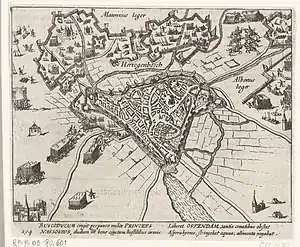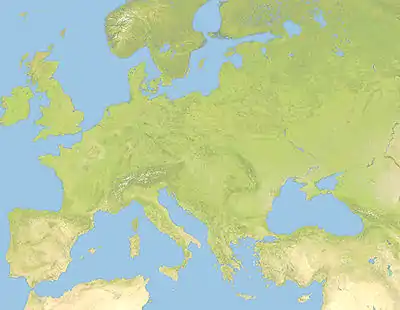| Siege of 's-Hertogenbosch (1601) | |||||||
|---|---|---|---|---|---|---|---|
| Part of the Eighty Years' War and the Anglo-Spanish War (1585–1604) | |||||||
 Map of the siege of 's-Hertogenbosch by Simon Frisius. | |||||||
| |||||||
| Belligerents | |||||||
|
|
| ||||||
| Commanders and leaders | |||||||
|
|
| ||||||
| Strength | |||||||
|
12,000–15,000[3] 22 guns[4] |
Anthonie Schetz: 2 infantry companies and 2 cavalry companies[5] Frederik van den Bergh: 7,000 infantry and 1,500 cavalry[5] | ||||||
 Location within Netherlands  Siege of 's-Hertogenbosch (1601) (Europe without the extreme north) | |||||||
The siege of 's-Hertogenbosch of 1601 (Sitio de Bolduque de 1601 in Spanish) was an unsuccessful Dutch attempt led by Prince Maurice of Nassau and William Louis of Nassau-Dillenburg to capture the city of 's-Hertogenbosch, North Brabant, Spanish Netherlands, garrisoned by about 1,500–2,000 Spanish soldiers (2 infantry companies and 2 cavalry companies) led by Governor Anthonie Schetz, Baron of Grobbendonck, between 1 and 27 November 1601, during the Eighty Years' War and the Anglo-Spanish War (1585–1604), in the context of the long and bloodiest siege of Ostend.[1][2][6]
After having captured Rheinberg in July 1601, Prince Maurice in October mobilized seventy-three companies of infantry and thirty-three companies of cavalry, including several pieces of artillery.[3] The city was virtually impregnable due to the great defensive fortifications, the continuous arrival of fresh Spanish reinforcements, and the deep loyalty of the population to the Catholic cause.[2][3] The fierce cold was another important point.[2] The siege ended when the Archduke Albert, Governor-General of the Spanish Netherlands, sent a Spanish relief force under Count Frederik van den Bergh from Ostend, who on 27 November had reached the town of Oirschot, some 25 km south of 's-Hertogenbosch.[2] A day before, on 26 November, Prince Maurice, according with his cousin William Louis about the threat and danger to facing the Spaniards in open field, started the withdrawal.[3][7]
This Dutch failure was also an attempt to weaken the Spanish attacks in Ostend, where Sir Francis Vere (the commander of the garrison of Ostend at that time) was by now close to despair.[7]
In 1603, Maurice of Nassau again tried to conquer 's-Hertogenbosch, but again was forced to withdraw.[8][9]
See also
Notes
- 1 2 Dutch Army and the Military Revolutions 1588–1688. Van Nimwegen p.179
- 1 2 3 4 5 Michiel Verweij p.31
- 1 2 3 4 Van Nimwegen p.178
- ↑ When the Dutch laid siege to 's-Hertogenbosch in 1601 they brought with them 22 cannons. Peter Burke p.204
- 1 2 Campaña de 1601 by Juan L. Sánchez Archived 2016-03-04 at the Wayback Machine
- ↑ Peter Burke p.204
- 1 2 Van Nimwegen p.179
- ↑ Michiel Verweij p.32
- ↑ Daniel Coetzee p.118
References
- Van Nimwegen, Olaf. The Dutch Army and the Military Revolutions 1588–1688. First published 2010. The Boydell Press, Woodbridge. ISBN 978-1-84383-575-2
- Michiel Verweij. Petrus Vladeraccus, Tobias (1598). Leuven University Press 2001. Belgium. ISBN 90-5867-177-1
- Tracy, James. The Founding of the Dutch Republic: War, Finance, and Politics in Holland 1572–1588. Oxford University Press. First published 2008.
- Daniel Coetzee/ Lee W. Eysturlid. Philosophers of War: The Evolution of History's Greatest Military Thinkers. ISBN 978-0-275-98977-4
- Williams, Penry (1998). The Later Tudors: England, 1547-1603. Oxford University Press. ISBN 0192880446.
- John Lothrop Motley. History of the Netherlands, 1595. Chapter XXXI. HardPress Publishing. ISBN 1-4076-2886-0
- Peter Burke. The New Cambridge Modern History: Volume 13, Companion Volume. Cambridge University Press 1979. ISBN 0-521-22128-5
External links
- Campaña de 1601 by Juan L. Sánchez (in Spanish)